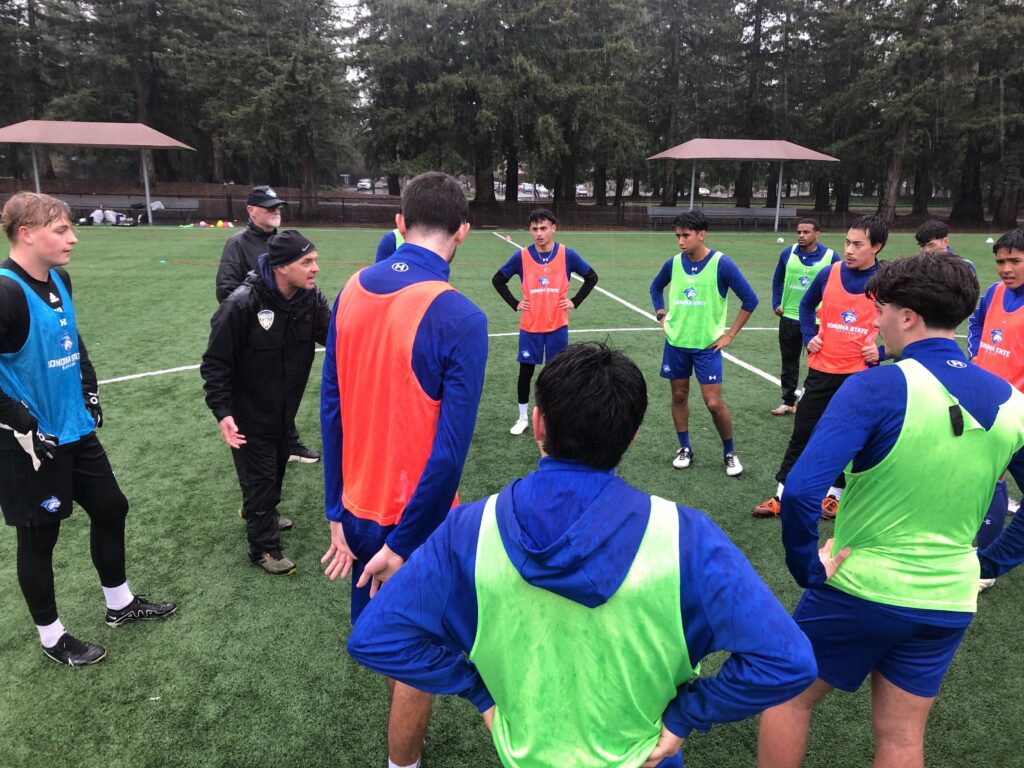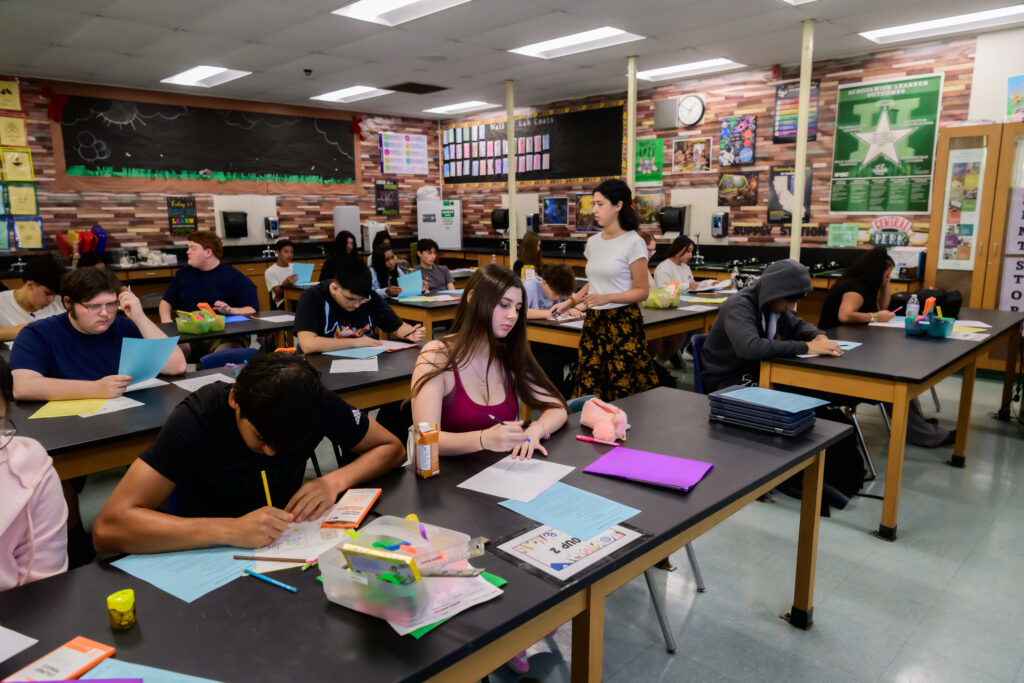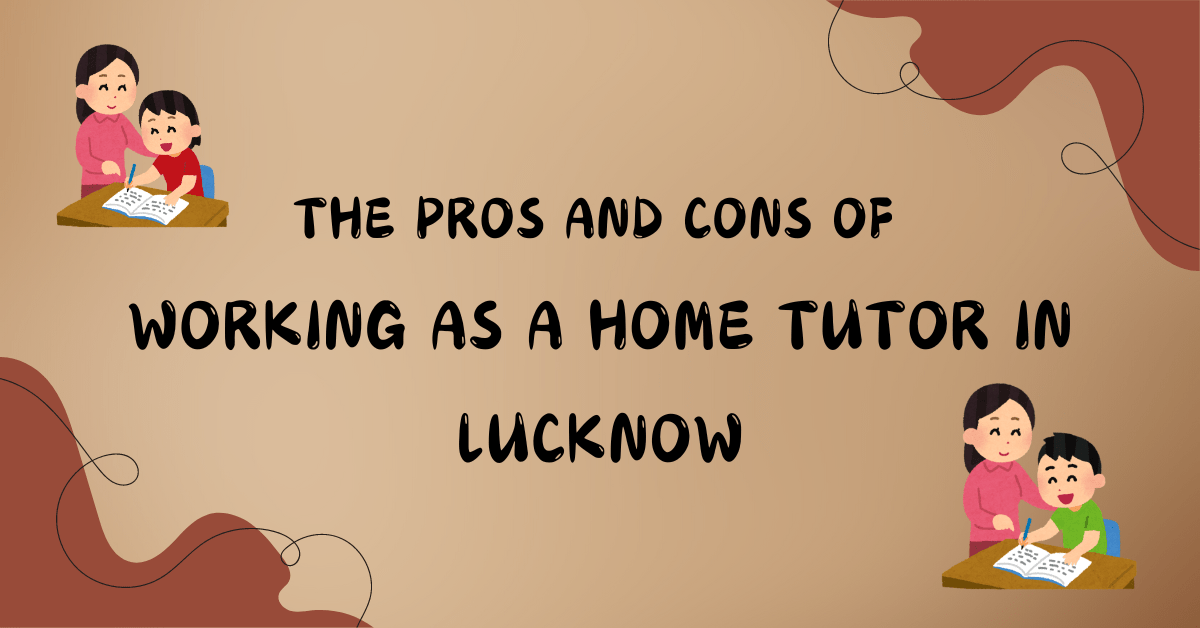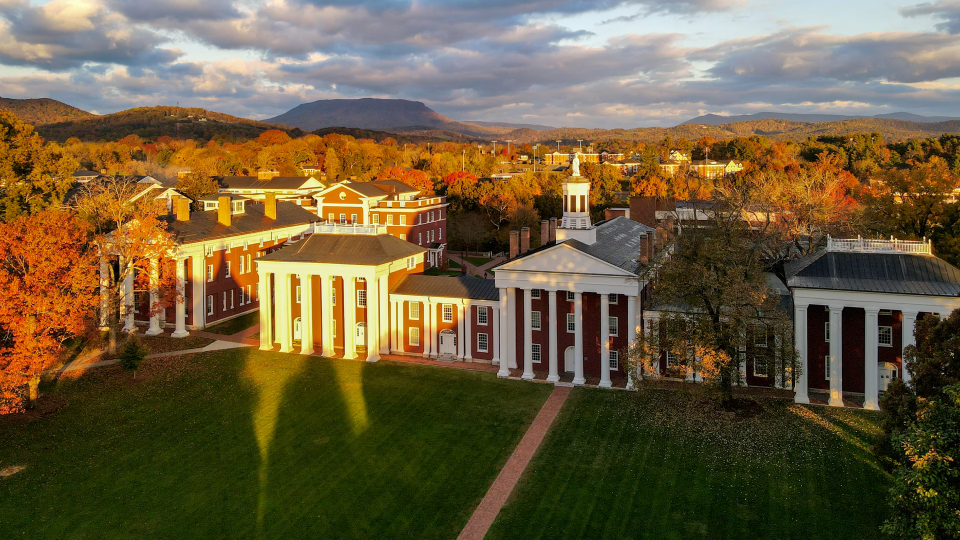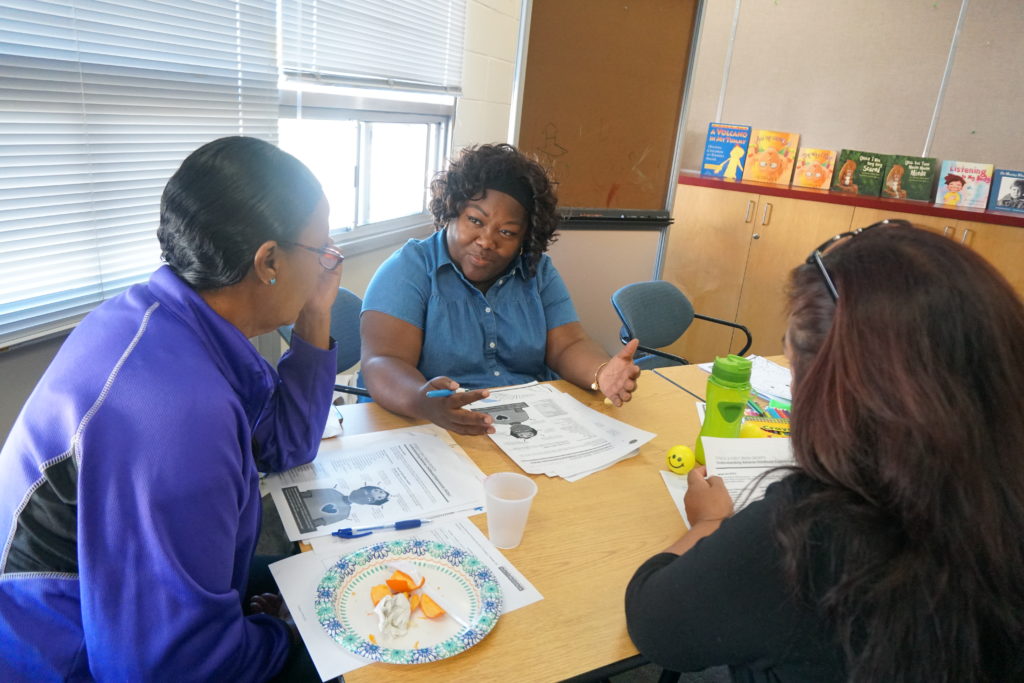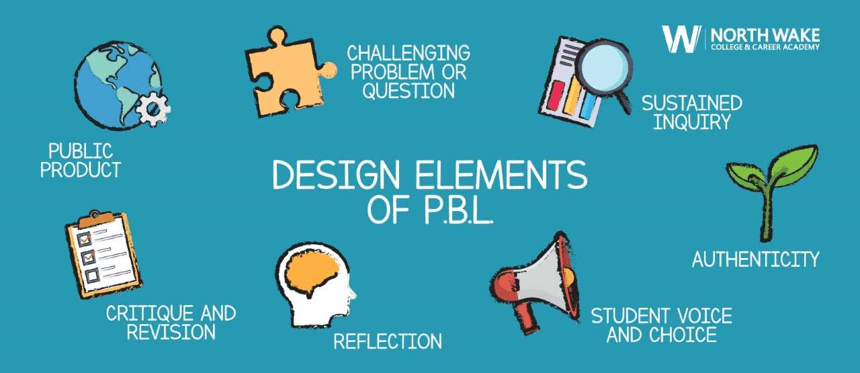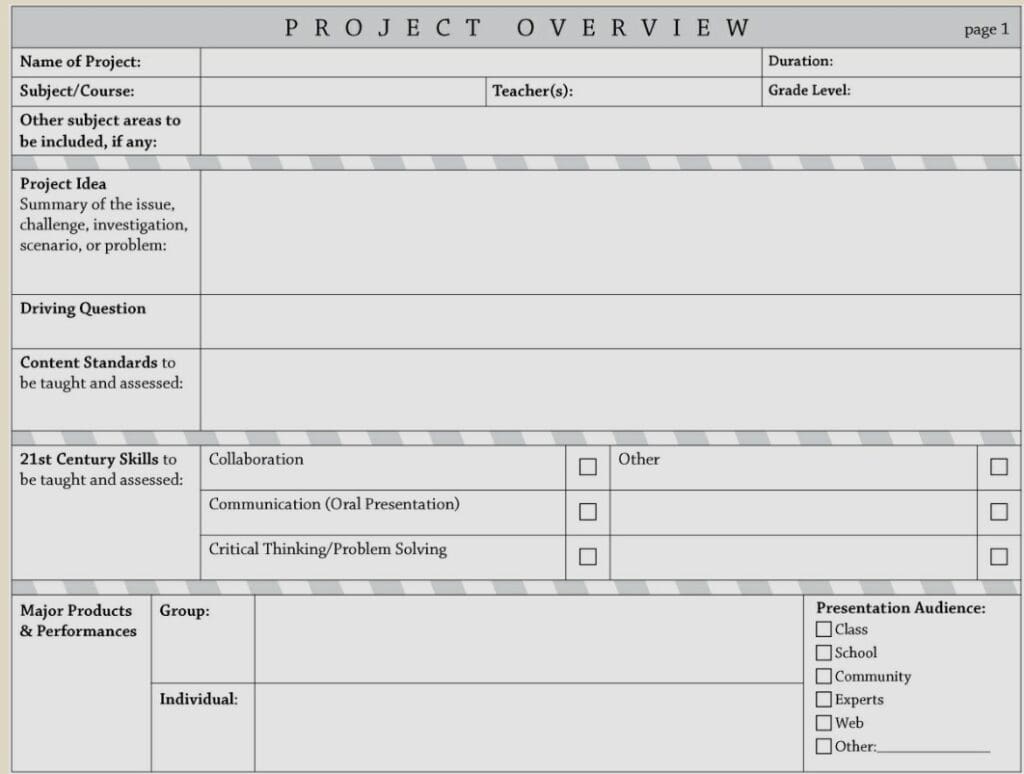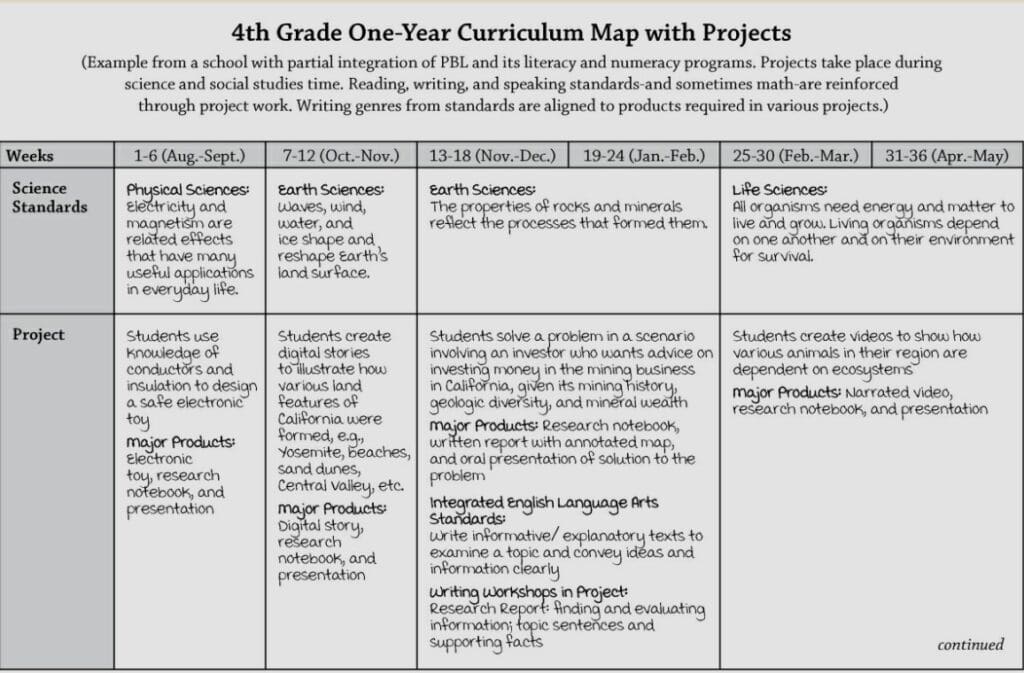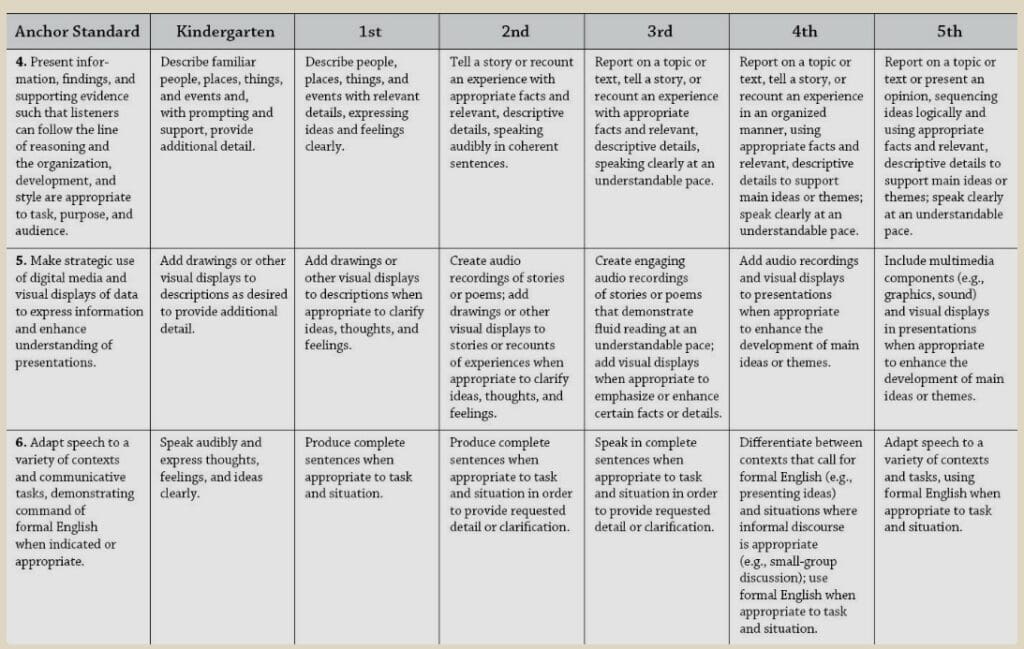
The Sonoma State University men’s soccer team practices in the rain recently on the campus in Rohnert Park. Division II sports are on the chopping block to save money.
Credit: Amy DiPierro / EdSource
On the soccer pitch, in the physics classroom and in the office of a trusted professor, students at Sonoma State University are confronting a demoralizing challenge: What happens if my program gets cut?
The Rohnert Park campus, 50 miles north of San Francisco, has announced a contentious proposal to close a $24 million budget deficit by nixing six academic departments entirely, eliminating about two dozen major degree programs and cutting all NCAA Division II sports, among other measures.
Sonoma State’s experience is the most dire example of the cost reductions at many of the 23 Cal State campuses, which in total serve more than 450,000 students around the state. The university system’s leaders say cuts are prompted by an anticipated decrease in state funding, rising costs and, on some campuses, slumping enrollment figures. The number of students at Sonoma State has plunged dramatically, from 9,400 students in 2015 to a nadir of about 5,800 in 2024.
On a recent visit to the campus, an EdSource reporter spent time with students, faculty and coaches directly impacted by the expected cuts. The most defiant promised to fight for reprieves or backed state legislators’ demands for a turnaround plan. This month, some students sued to try to block proposed cuts.
But mostly, students and faculty expressed worry that this could be the last time a Sonoma State undergraduate sees the advanced math explaining why light moves more slowly in air than in a vacuum, ponders the differences between second and third wave feminism or masters the subtle finesse of playing one-touch soccer in the rain.
Geology: ‘All of that will be gone’
Jackson Kaiser grew up at the foot of Mount Konocti in Lake County, part of a volcanic field three hours north of San Francisco that feeds what is reckoned to be the largest geothermal complex in the world. “I had a lot of questions that I didn’t know how to answer,” he said. And that’s why he majored in geology at Sonoma State University.
But the department that has turned Kaiser’s curiosity into a promising career may soon disappear. Kaiser could be among the last 40 or so Sonoma State geology majors, according to a professor in the department, if the university goes ahead with plans to eliminate the department. Sonoma State spokesperson Jeff Keating confirmed that all tenured and tenure-track geology faculty have received layoff notices, though several may be asked to teach temporarily.
On a recent Wednesday afternoon, Kaiser reverently held his favorite rock samples in the classroom where geology majors take most of their classes. “The idea that that place won’t be here to come back to, that I won’t have an alma mater — it feels like our administration doesn’t want me to be a proud Seawolf,” he said, referring to the campus mascot.

Kaiser, 36, was working in the produce department of a Safeway grocery store when he found himself researching the chemical formulas of minerals. He marveled at their straight lines and geometric forms, so elegant they appear unnatural. He wanted to know more.
So around 2022, Kaiser, his partner and their two children, now 4 and 6, started commuting an hour and half or more every weekday from Lake County to Sonoma State, sending the kids to the Children’s School on campus while both parents took undergraduate classes. These days, Kaiser bunks with classmates from Monday to Friday, returning home to his family on weekends. “It’s not great,” he said. “But I’m working towards a better future, where I’ll have a real career and not just be working in a grocery store.”
His chosen career can have high stakes. After all, Kaiser said, it was a careful geological study in the 1960s that ultimately blocked a plan to build a nuclear power plant just 30 minutes from campus on a site traversed by the San Andreas Fault. A geological assessment is often a necessity for construction projects, especially in a region where debris flows can follow climate change-fueled wildfires. But geologists worry their numbers are waning despite growing demand for their skills.

Kaiser, who will graduate at the end of the summer, has been collecting business cards from potential employers like geologic consulting firms. Thanks to the department’s frequent field trips, he’s had opportunities to practice skills like mapping, sample collection and paleontology.
He’s also taken part in department traditions, like feasting on watermelon at the summit after mountainous hikes or visiting the mammoth fossil that Sonoma State students excavated in 1981. “I hate the thought,” he said, “that all of that will be gone.”
Soccer: ‘Play all the way through’
The weather was lousy, but there they were in the rain at 9:15 a.m., the Sonoma State University men’s soccer team, lacing up their boots and stowing their belongings in white garbage bags to keep them dry. They had come from nearby Santa Rosa and far away Kapolei, Hawaii, to attend the university. Together, they navigated the difficult reality that this could be their team’s last season, no matter how well they played.
There was Carson Sterling, a freshman center back from 18 miles north in Windsor, whose father and mother played soccer for Sonoma State before him. There was defender Cameron Fisk, a junior from Los Angeles studying business marketing, who had rebounded from injuries to play this fall. And, of course, there was head coach Marcus Ziemer, leading the Seawolves for the 34th year.
Ziemer watched the players warm up, his eyes shielded from the drizzle under a black baseball cap and glasses. Since he started as head coach in 1991, the men’s soccer team has won eight conference championships and earned its first and only national title in 2002.
But now things are grim. The university announced on Jan. 22 that it planned to eliminate men’s soccer along with the school’s other NCAA sports, among other austerities.
“It’s a very difficult kind of limbo right now,” he said. “We’re fighting hard to try and save the program and some of the other majors as well, trying to get them to reconsider.”
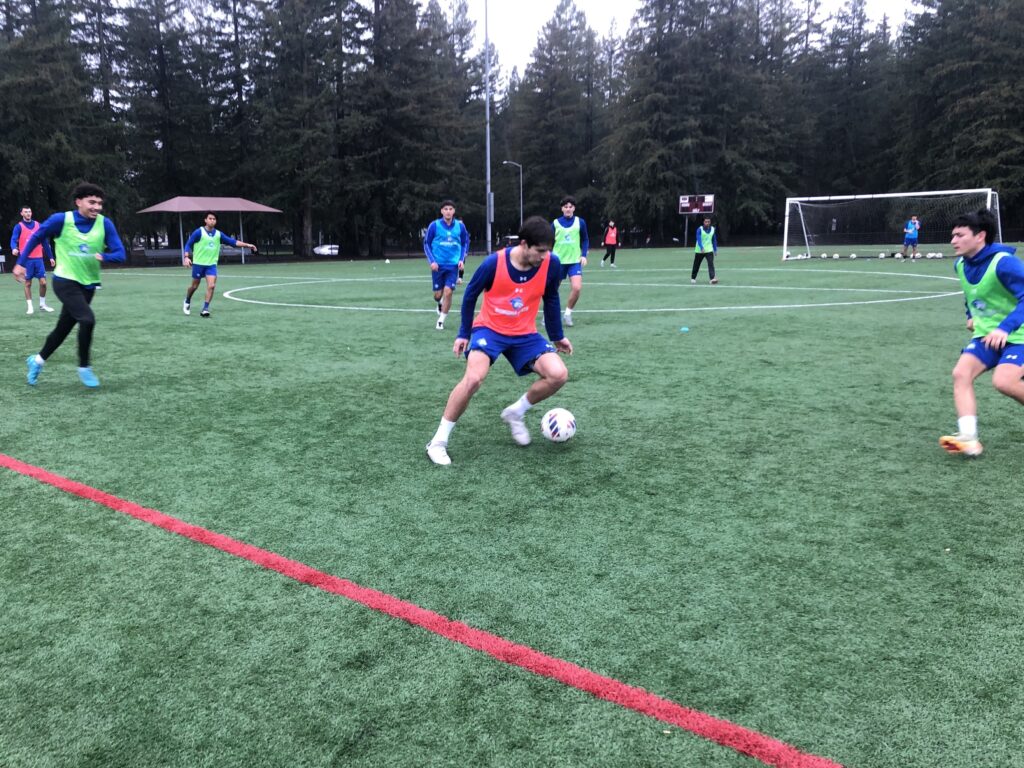
Ziemer himself is in limbo, too. Unless efforts to save the Sonoma State Division II sports programs succeed, his contract will end on June 30. He would probably retire rather than seek another coaching job.
In the meantime, Ziemer and his four assistant coaches have advised players who wish to continue their collegiate soccer careers to enter the NCAA transfer portal, expressing interest in moving to other schools. A few already have offers.
“I’m just grateful that with everything going on, we have coaches like them that are willing to help us and see other opportunities,” said Fisk, who has entered the transfer portal while the Sonoma State team’s status is uncertain.
But for now, the team’s focus was on preparing the Seawolves for a challenging spring season, including matchups against NCAA Division I and semi-professional sides. Practice started with dynamic stretches, then a frenetic game of keep-away and a shooting drill to loosen quads grown stiff in the damp.
“The energy is still really high,” said Sterling, who is in talks with soccer programs at other schools. “Obviously, it’s a kind of bad situation, and we’re just hoping for the best. But we’re going to play all the way through no matter what, and we’re going to play hard for each other.”
The squad split into teams for a scrimmage, an assistant coach barking urgent encouragement as they played. He called a time-out. “What does it take? Communication. Thinking one pass, two passes, three passes ahead. Moving, adjusting, being aware,” he yelled, his voice booming over the slick turf. “So because we’re struggling, should we say, ‘Ehh, f— it, move on.’? Or should we grow through it? Let’s grow through it — let’s grow through it together!”

Women’s and gender studies: ‘I didn’t get that anywhere else’
Under the fluorescent lights of a windowless basement classroom, Xochilt Martinez Balladares and about 20 other students eagerly awaited a discussion on queer and trans theory. But before they could unpack works by critical heavyweights like Adrienne Rich, they trained their attention on an issue closer at hand: the plan to dismantle the Sonoma State University Women’s and Gender Studies Department.
If the proposal goes forward, Sonoma State will offer the last women’s and gender studies classes in spring 2026. That could mark the end of a more than 50-year run that started with the founding of the program in the early 1970s and evolved into the Women’s and Gender Studies Department in 2001. Several students said the plan compounds their feeling that historically marginalized groups are under attack as the Trump administration seeks to end diversity, equity and inclusion efforts.
Martinez and her classmates also argued that the department teaches skills central to future careers, while providing community when they need it most. For Martinez, a women’s and gender studies major and Chicano and Latino studies minor, the long-term goal is to go into immigration law. In the short-term, she is considering a social work degree so she can work with at-risk youth and families.
“I almost dropped out twice because I felt very out of place,” said Martinez, 32. But she persevered thanks to a women’s and gender studies instructor who “talked to me on a personal level and made sure that I could continue my education. I didn’t get that anywhere else.”
The department typically attracts 25 to 35 majors a year, said Don Romesburg, the professor who teaches the theory course, but many more students who aren’t majors take its classes. Campus spokesperson Keating confirmed that all the department’s professors have been laid off, but said the university “will continue to support and encourage the teaching of courses that support women’s rights and the rights of the LGBTQIA+ community.”
Janis Phillips, 46, an education graduate student, said the loss of the department makes her question whether the university shares her commitment to students’ social and emotional learning.
“When students feel safe and seen and heard on campuses, that is one of the best predictors of academic success,” she said, facing her classmates around the circle of desks. “So to take a bunch of students and make them feel like they are not seen and not heard will be detrimental to their academic success.”
Students said the major prepares them for careers as psychologists, marriage and family therapists or health care providers. Because majors have to complete a community service requirement, students work with local organizations that help unhoused families, prevent sexual assault and support LGBTQ youth. “We’ve really taken seriously this question that parents often ask their students, which is, ‘What would you do with that degree?’” Romesburg said.
Despite the uncertain future of the department, students are doing the reading, Romesburg said, mindful that those who come behind them might not get the same opportunity. “They’re ready to roll up their sleeves and do project-based work, where they’re really generating ideas and reflections and engaging with the material,” he said.

Physics: ‘Watching something that you love die’
The physics students filing into Scott Severson’s 9:30 a.m. optics class brightened with the wide-eyed surprise of children peeking at a gift: a sturdy wooden crate.
“It’s Christmas in our labs,” Severson said, gesturing toward the crate, which was filled with professional-grade laboratory hardware. “We ordered this in better days,” he added, and a few students chuckled.
The Sonoma State Physics and Astronomy Department has indeed seen better days. Its alumni have gone on to lead companies, earn advanced degrees and become professors themselves. One of the department’s proudest moments came in 2016, when professor Lynn Cominsky was part of the team that documented a phenomenon called gravitational waves, an achievement that won three of her collaborators the Nobel Prize. Cominsky said she has raised more than $43 million in grants for Sonoma State.
Such prestige has not shielded the Physics and Astronomy Department from cost-cutting plans. Though the department will avoid total elimination, Sonoma State plans to phase out its physics major. It is giving 30 majors two years to graduate and leaving 10 first-year students to find another degree or transfer, Severson said. After that, physics faculty members will only teach physics courses for students in other programs, like biology or engineering.
Already, one of the department’s lecturers has received a layoff notice, according to the university. Severson said he and three other remaining tenured faculty will cover the teaching load as the physics degree winds down. He doesn’t anticipate that tenured faculty will lose their jobs, but said some may seek work elsewhere or retire.

Ending the physics major also could reverberate at Cominsky’s EdEon STEM Learning program, which creates educational materials aimed at inspiring middle and high school students to pursue careers in science, technology, engineering and math.
EdEon’s work depends on Sonoma State undergraduates, Cominsky said, and currently employs between 15 and 20 students in fields including physics. “None of the research grants I write would have been possible without physics majors,” she said.
Meanwhile, the students in Severson’s optics class watched as he played them a video illustrating the spiral of two black holes.
“I want you to notice the colors of this,” said Severson, who has taught at the university since 2007. “The brighter the red, the greater the distortion of spacetime as this is happening.”
Among the optics students was Madison Ambriz, who plans to graduate at the end of fall 2025. Ambriz spent the summer learning to assemble circuit boards as part of a collaboration to upgrade the Large Hadron Collider, a famed particle accelerator used to test physicists’ theoretical predictions. “I had such a blast with it,” she said, but her enthusiasm has been tempered by the feeling that it’s too late to save the major.
“It doesn’t matter what we say, doesn’t matter how heartbroken we are, doesn’t matter what the numbers say, they’re still going to cut the [major],” Ambriz said. “And it’s just watching something that you love die, and it’s horrible.”
